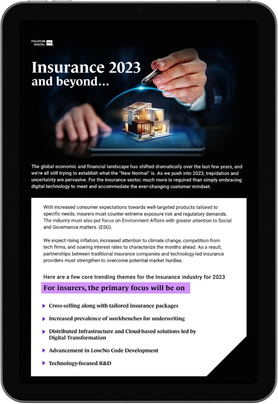Customer service digitization is the next wave of innovation in the insurance industry. By choosing the right digital solutions, insurers can help enhance customer satisfaction and long-term survival in a competitive market.
For decades, carriers and brokers relied on human-to-human interactions at virtually every level of the client experience. Then, social distancing accelerated the digitization process. Although insurers are making progress, there is still work to be done, particularly in claims, customer service automation, and the move to cloud infrastructures.
Regardless of its size or structure, almost every insurance company must decide on the best course of action when going digital. Delayed adoption within the insurance sector has left many established companies vulnerable to new entrants that cater to customers using digital solutions.
Why Digital Solutions Are Critical in the Insurance Industry
“Digital transformation” is a word you have undoubtedly heard before. Many industries, including the commercial enterprise, manufacturing, retail, hospitality, and healthcare segments, leverage technology to optimize the customer experience.
Historically, insurance has been slow to adapt, but now more than ever, insurers must embrace transformation. Improvements in productivity, personalization of services, agility, and scalability are the most significant benefits of digital insurance solutions. As policyholders’ needs continue to evolve, top players in the insurance industry need to stay focused on adjusting their user experiences.

INSURANCE 2023 AND BEYOND
Delve into the key points insurers must focus on to meet the increasing customer expectations and comply with the new regulatory requirements.
For example, many consumers are accustomed to the conveniences of shopping online and expect their insurers to provide the same quality of services. Policyholders want to speak with their brokers through a Zoom call rather than be limited to in-person meetings.
Must-Have Digital Capabilities
As a recent study suggests, insurers need to prepare themselves with industry newcomers like Insurtechs will win over as much as one-third of premium insurance volumes within the next three years. Carriers and local agencies can ensure their future positions by achieving a holistic customer experience that focuses on more service-led products.
As quickly as technology is maturing, insurance companies need to choose digital services wisely. There are several key features to look for in platforms that can simplify the choice. Tools with configurations, scalability, direct-to-consumer capabilities, integrations, accessibility, and speed-to-market solutions contribute to the most impactful business outcomes.

1. Configurations
A configurable framework allows end-users to make simple system changes without knowing any code. Insurance companies using outdated legacy systems understand the importance of configurations.
For example, changing one of the data fields to assess a product performance metric is quick and straightforward for insurers with a configurable framework. After one click of a button, any team member can add the new metric.
2. Scalability
Cloud-based platforms create space for scalable growth and are one of the most valuable digital resources in the insurance market. Scalability reduces costs since companies only pay for the digital assets they need.
This feature is essential because it drives overall efficiency, allows for seasonal or temporary expansion initiatives, and optimizes performance.
3. Low Code/No Code
In technology, low code, no-code, or rapid development refers to the visual appearance of the user interface. When developers want to add or change a property in the system, an intuitive interface can accelerate the process. For example, instead of writing individual lines of code, low code would allow you to press a button to achieve the desired outcome.
This capability makes tools more accessible to individuals with limited technology experience. If an agency needs to make any quick adjustments, low code makes it easy for any team member to log in and quickly make the change.
4. Direct-to-Consumer Services
Brands leveraging direct-to-consumer sales tactics continue to thrive as an increasing number of customers prefer to interact directly with companies. Without an intermediary, businesses grow revenues, expand their customer reach, and gain access to new policyholder insights. Traditionally, insurers relied on agents and brokers to complete sales.
Now, offering people the option to purchase coverage from home is a prime strategy for boosting customer loyalty.

5. Integrations
Technology integration solutions using APIs for insurance platforms are ideal for keeping agencies interconnected. For example, if a customer provides information via one office, an integrated platform will automatically change the entry across all databases.
Software integrations enhance technology solutions in other ways like real-time claims processing. One of the benefits of platform integrations is going paperless while creating a seamless customer-facing experience.
6. Speed-to-Market
A system that supports speed-to-market capabilities is essential to respond to urgent changes in the insurance market. Speed-to-market is critical, especially in the insurance segment, where the first carrier to release a relevant product has a significant opportunity to win brand recognition.
By establishing a barrier-free process for launching new policies quickly, competitors can position themselves to capitalize on these opportunities when they arise.
Final Thoughts
Digital insurance solutions become less intimidating when companies take a holistic approach to digitization. First, define your organization’s goals and identify opportunities for improvement. Then, implement the digital solutions that streamline ineffective processes.
At Fulcrum Digital, our digital transformation services for insurance companies can optimize actuary services, claims, contract lifecycle management, medical record reviews, and policy administration tasks.







